Infrastructure and Operations Priorities 2023

- Get out of your I&O silo. I&O teams must be expected to work alongside and integrate with cyber security operations.
- Being unprepared for new ESG reporting mandates without a clear and validated ESG reporting process puts your organization at risk.
- Get ahead of inflationary pressures with early budgetary planning and identify the gap between the catchup projects and required critical net new investments.
Our Advice
Critical Insight
- Establish I&O within an AI governance program to build trust in AI results, behaviors, and limit legal exposure.
- Develop data governance program that includes an I&O data steward for oversight.
- Ready or not, the metaverse is coming to an infrastructure near you. Start expanding I&O technologies and processes to support a metaverse infrastructure.
Impact and Result
- Provide a framework that highlight the impacts the threats of an economic slowdown, growing regulatory reporting requirements, cyber security attacks and opportunity that smart governance over AI, data stewardship and the looming explosion of augmented reality and Web 3.0 technologies.
- Info-Tech can help communicate your I&O priorities into compelling cases for your stakeholders.
Infrastructure and Operations Priorities 2023 Research & Tools
Besides the small introduction, subscribers and consulting clients within this management domain have access to:
1. Infrastructure & Operations Priorities 2023 – A framework to dive deeper into the trends most relevant to you and your organization
Discover Info-Tech's six priorities for Infrastructure & Operations leaders.
Infographic
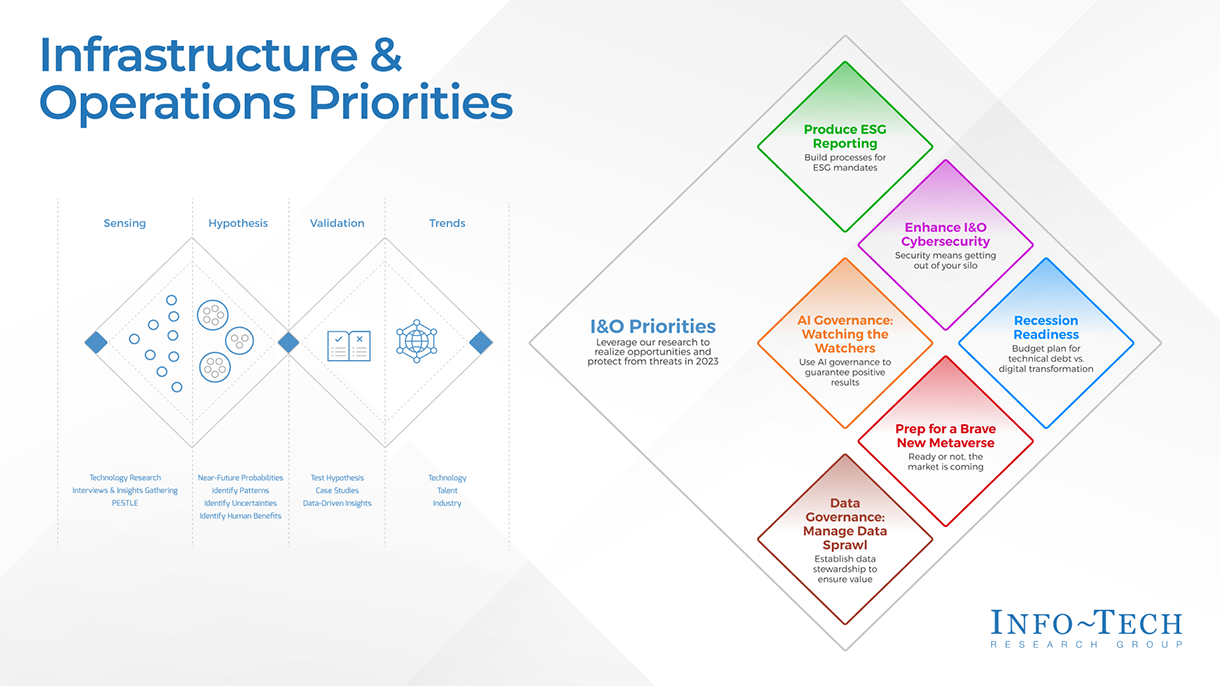
Further reading
Infrastructure &Operations Priorities 2023
Navigate the liminal space between threats and opportunities.
2023: A liminal space between threats and opportunities
|
Over the last several years, successful CEOs turned to their Infrastructure and Operations (I&O) departments to survive the effects of the pandemic. It was I&O leaders who were able to reconfigure critical infrastructure on the fly to support remote work, adapt to critical supply chain shortages, and work with lines of business managers to innovate operational workflows. 2023 promises to bring a new set of challenges. Building on the credibility established during the pandemic, I&O is in a unique position to influence the direction a business will take to be successful in a time of austerity. I&O members are going to be asked to mitigate the threats of volatility from recession pressures, new cybersecurity attacks, and operational process and litigation from regulatory mandates. At the same time, I&O members are being asked for fundamental digital transformation items to realize long-term opportunities to their organizations in 2023. Seemingly counter-intuitive in a time of economic slowdown, organizations in 2023 will want to start the groundwork to realizing the I&O opportunities that unstructured data and artificial intelligence have promised, while prepping for what has been mislabeled as the Metaverse. |
If you are in a traditionally risk adverse industry, you’re more likely to be impacted by the threat mitigation. Opportunistic I&O members will use 2023 to proactively jumpstart digital transformation. |
Introduction
Welcome to the Info-Tech 2023 I&O Priorities Report
|
If I&O members learned anything from the last few years, it’s how to tactically respond to the disruptive waves often arising from sources external to the organization. The good news is that Info-Tech’s I&O priorities report provides forward-looking insights to help members become more proactive to the tsunami of change predicted in our Trends Report to happen over the next three to five years. Info-Tech I&O priorities are generated through a phased approach. The first phase senses and identifies mega and macro tends in the digital landscape to formulate hypotheses about the trends for the next three to five years. These hypotheses are validated by sending out a survey to Info-Tech members. The responses from 813 members was used to produce an Info-Tech Trends Report focused on major long-term trends. The I&O Priorities were determined by combining the I&O member responses within the Info-tech Trends Survey with insightful signals from secondary research, economic markets, regulatory bodies, industry organizations, and vendors. The six I&O priorities identified in this report are presented in a framework that highlight the impacts of an economic slowdown, growing regulatory reporting requirements, cybersecurity threats, smart governance of AI, embracing stewardship of data, and the looming explosion of augmented reality and Web 3.0 technologies. We also have a challenge exercise to help you communicate which priorities to focus your I&O organization on. Additionally, we linked some Info-tech research and tools related to the priorities that help your I&O organization formulate actionable plans for each area. |
Priorities Six forward-looking priorities for the next year. Focus Activity to help select which priorities are relevant for you. Actions Actionable Info-tech research and tools to help you deliver. |
Infrastructure & Operations priorities
The I&O priorities were determined by combining I&O member responses from the Tech Trends and Priorities 2023 survey with insightful signals from secondary research, economic markets, regulatory bodies, industry organizations, and vendors.
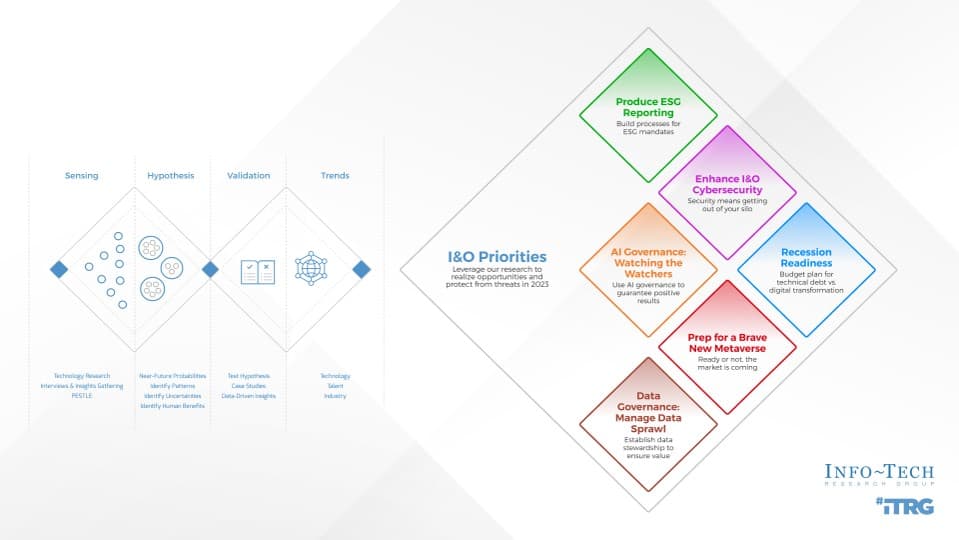
I&O Priorities 2023

I&O priorities framework
|
Threats signals Enhance I&O Cybersecurity Produce ESG Reporting Recession Readiness |
Get out of your silo. Forget your job description and start doing what needs to be done. Infrastructure rarely has authority in these areas, but somehow it ends up with many of the responsibilities. You can't afford to be reactive. Forget about your traditional silo and get out in front of these topics. Not in your job description? Find out whose job it is and make them aware. Better yet – take charge! If you're going to be responsible you might as well be in control. |
|
Opportunities signals AI Governance: Watching the Watchers Prep for A Brave New Metaverse Data Governance: Cornerstone of Value |
Proper stewardship of data is an I&O must. If thought you had problems with your unstructured data, wait until you see the data sprawl coming from the metaverse. I&O needs to be so much more than just an order taker for the dev teams and lines of business. The sprawl of unstructured data in Word, Excel, PDF and PowerPoint was bad historically; imagine those same problems at metaverse scale! Simple storage and connectivity is no longer enough – I&O must move upstream with more sophisticated service and product offerings generated through proper governance and stewardship. |
Challenge: Expand the I&O border
|
The hidden message in this report is that I&O priorities extend beyond the traditional scope of I&O functions. I&O members need to collaborate across functional areas to successfully address the priorities presented in this report. Info-Tech can help! Align your priorities with our material on how to Build a Business-Aligned IT Strategy. Use a modified version of the Strategy Initiative Template (next slide) to convey your strong opinion on the priorities you need your stakeholders to know about. And do so in a way that is familiar so they will easily understand. |
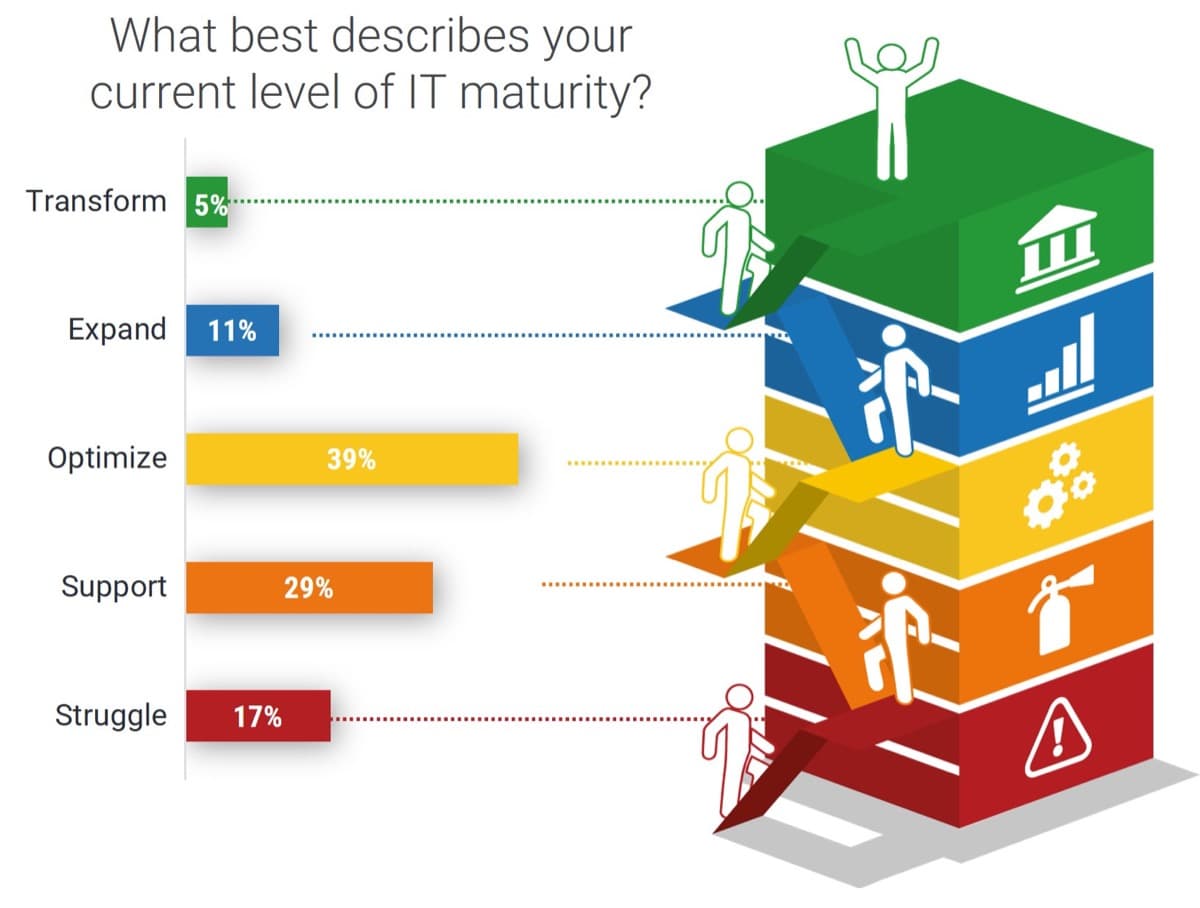
Info-Tech 2023 Trends Survey Results |
|
Call your Executive Advisor or Counselor to help identify the one or two key messages you want to bring forward for success in 2023! |
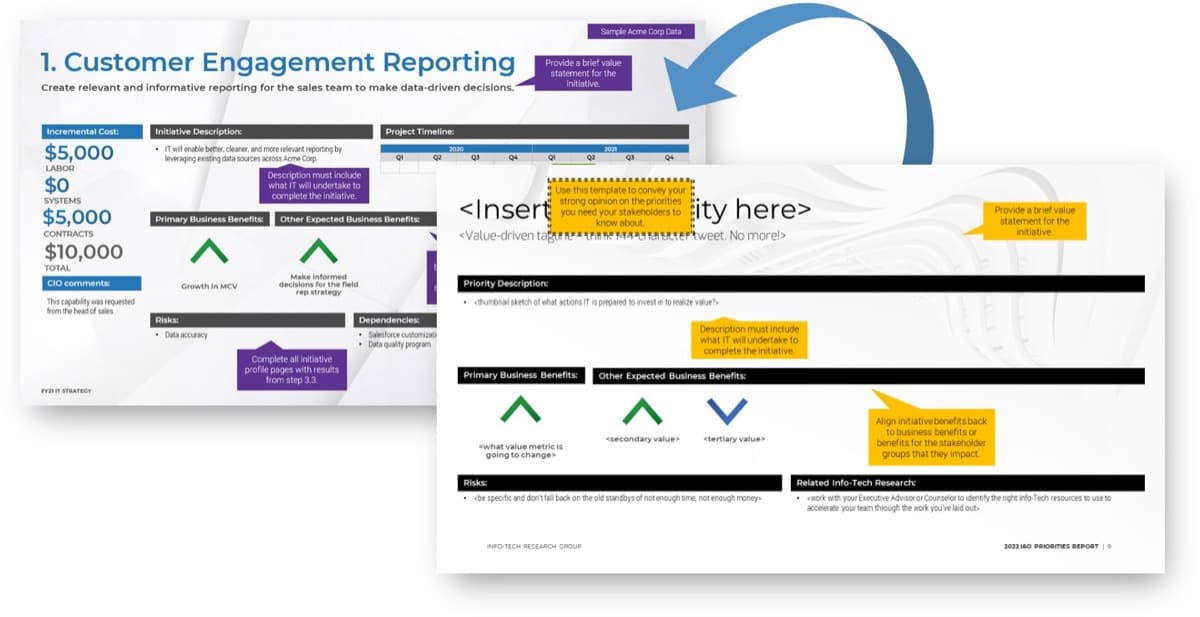
Info-Tech IT Strategy Initiative Template, from the IT Strategy Presentation Template & Priorities Report Initiative Template . |
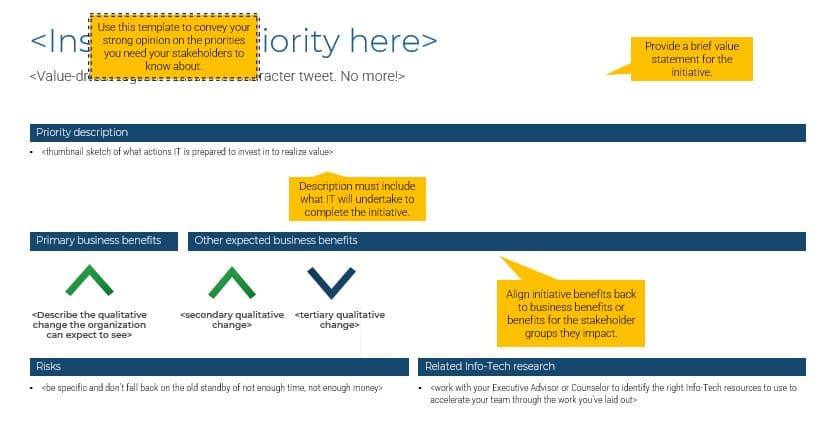
Protect from threats
Get out of your silo. Forget your job description and just start doing what needs to be done.
Enhance I&O Cybersecurity
Produce ESG Reporting
Recession Readiness
Enhance cybersecurity response
SIGNALS
|
Cybersecurity incidents are |
Cybersecurity incidents have |
Related Info-Tech Research |
|---|---|---|
|
Of the surveyed I&O members, 53% identified cybersecurity incidents as the number one threat disrupting their operations in 2023. It’s understandable, as over 18% of surveyed I&O members experienced a cybersecurity incident in 2022. Alarmingly, 10% of surveyed I&O members didn’t know if they had a cybersecurity incident. The impact to the organization was with 14% of those incidents directly impacting their organizations for anywhere from 6 to 60 days. |
The 2022 report “Cost of a Data Breach” was conducted by IBM and the Ponemon Institute using data from 550 companies (across 17 countries) that experienced a security incident during a 12-month period ending in March 2022. It highlighted that the average total organizational cost of a security breach globally was USD 4.35M (locally these numbers expand to USA at USD 9.44M, Canada at USD 5.64, UK at USD 5.05M, Germany at USD 4.85M). (Source: IBM, 2022) |
Enhance cybersecurity response
SIGNALS
Organizations' exposure comes from internal and external sources. | The right tools and process can reduce the impact of a cybersecurity incident. | Related Info-Tech Research |
|---|---|---|
The IBM/Ponemon Institute report highlighted the following:
(Source: IBM, 2022) | The IBM/Ponemon Institute report also identified technologies and procedures to reduce the fiscal impacts of cybersecurity breaches. Having a dedicated security incident response team with a regularly tested plan reduced the incident cost by an average of USD 2.66M. A fully implemented AI security deduction and response automation system can provide average incident savings of 27.6%. |
Enhance cybersecurity response
SIGNALS
|
Cybersecurity spending is a major and expanding expenditure for our members. |
Cybersecurity is going |
|
|---|---|---|
|
For 36% of surveyed I&O members, cybersecurity consumed between 10-20% of their total budget in 2022. Moreover, cybersecurity defense funding is expected to increase for 57% of I&O members. |
A third of surveyed I&O members viewed misinformation as a major risk to their organization for 2023 and 2024. Only 38% of the I&O members reported that they will have software in place to monitor and manage social media posts. |
Increasing environment and regulatory complexity demands more sophisticated cybersecurity operations. Infrastructure teams must be expected to work alongside and integrate with cybersecurity operations. |
Enhance cybersecurity response
CALL TO ACTION
Get out of your I&O silo and form cross-functional cybersecurity teams.
I&O priority actions
Establish a cross-functional security steering committee to coordinate security processes and technologies. The complexity of managing security across modern applications, cloud, IoT, and network infrastructure that members operate is greater than ever before and requires coordinated teamwork.
Contain the cyber threat with zero trust (ZT) architecture. Extend ZT to network and critical infrastructure to limit exposure.
Leverage AI to build vigilant security intelligence. Smart I&O operators will make use of AI automation to augment their security technologies to help detect threats and contain security incidents on critical infrastructure.
Enhance cybersecurity response
I&O priority actions
Build specialized cybersecurity incident management protocols with your service desk. Build integrated security focused teams within service desk operations that continually test and improve security incident response protocols internally and with specialized security vendors. In some organizations, security incident response teams extend beyond traditional infrastructure into social media. Work cross-functionally to determine the risk exposure to misinformation and incident response procedures.
Treat lost or stolen equipment as a security incident. Develop hardware asset management protocols for tracking and reporting on these incidents and keep a record of equipment disposal. Implement tools that allow for remote deletion of data and report on lost or stolen equipment.
Produce ESG reporting
SIGNALS
Government mandates present an operational risk to I&O members. | ESG reporting is | Related Info-Tech Research |
|---|---|---|
Surveyed members identified government-enacted policy changes to be a top risk to disrupting to their business operations in 2023. One of the trends identified by Info-Tech is that the impact of regulations on environmental, social, and governance (ESG) reporting are being rolled out by governments worldwide. | Alarmingly, only 7% of surveyed members responded that they could very accurately report on their carbon footprint and 23% said they were not able to report accurately at all. |
Produce ESG reporting
SIGNALS
ESG mandates are being rolled out globally.
ESG reporting has greatly expanded since a 2017 report by Task Force on Climate-Related Financial Disclosures (TCFD, 2017) which recommended that organizations disclose climate-related financial metrics for investors to appropriately price climate-related risks to share price. In 2021, the Swiss Finance Institute research paper (Sautner, 2021) identified 29 countries that require ESG reporting, primarily for larger public companies, financial institutions, and state-owned corporations.
Global ESG mandates
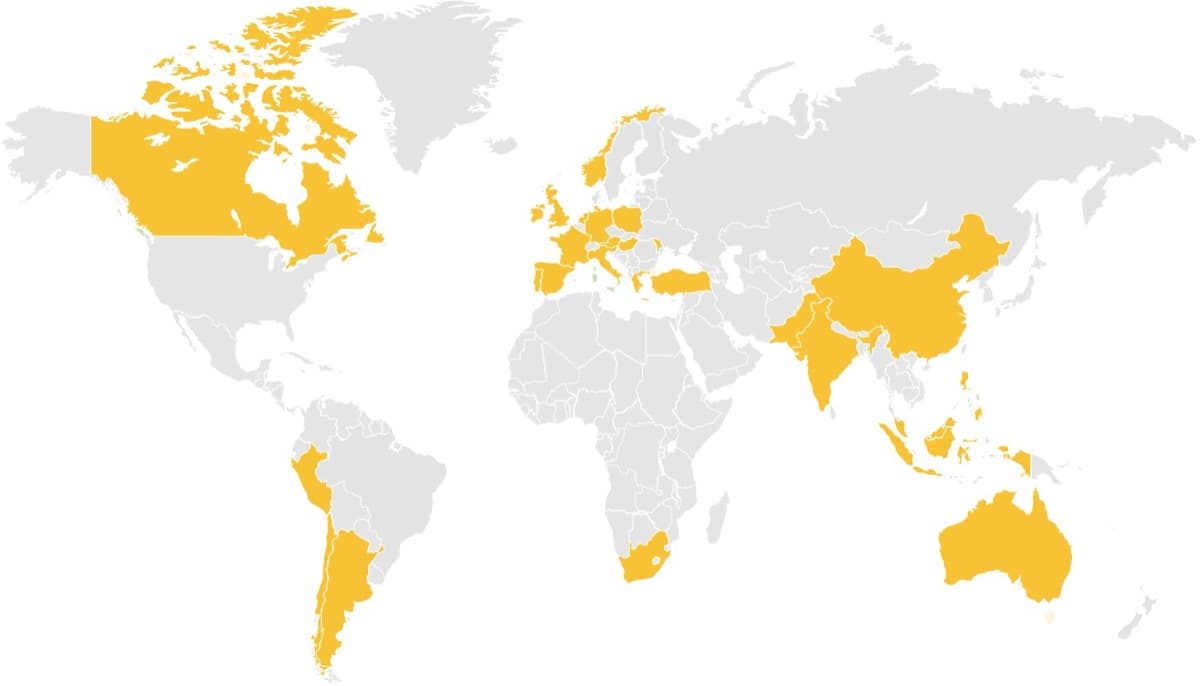
29 nations with ESG mandates identified by the Swiss Finance Institute
Produce ESG reporting
SIGNALS
|
ESG mandates are being rolled out globally. |
|
|
The EU has mandated ESG reporting for approximately 11,700 large public companies with more than 500 employees under the Non-Financial Reporting Directive (NFRD), since 2014. The EU is going to replace the NFRD with the Corporate Sustainability Reporting Directive (European Council, 2022), which has set a 3-year timetable for escalating the ESG reporting level to what is estimated to be about 75% of EU total turnover (WorldFavor, 2022).
|
It's been a long time since most enterprises had to report on things like power efficiency factors. But don't think that being in the cloud will insulate you from a renewed interest in ESG reporting. |
Produce ESG reporting
CALL TO ACTION
Being unprepared for new ESG reporting mandates without a clear and validated ESG reporting process puts your organization at risk.
I&O priority actions
Understand ESG risk exposure. Define the gap between what ESG reporting is required in your jurisdiction and current reporting capabilities to meet them. Build the I&O role with responsibility for ESG reporting.
Include vendors in ESG reporting. Review infrastructure facilities with landlords, utilities, and hosting providers to see if they can provide ESG reporting on sustainable power generation, then map it to I&O power consumption as part of their contractual obligations. Ask equipment vendors to provide ESG reporting on manufacturing materials and energy consumption to boot-strap data collection.
Implement a HAM process to track asset disposal and other types of e-waste. Update agreements with disposal vendors to get reporting on waste and recycle volumes.
Produce ESG reporting
I&O priority actions
Implement an ESG reporting framework. There are five major ESG reporting frameworks being used globally. Select one of the frameworks below that makes sense for your organization, and implement it.
ISO 14001 Environmental Management: Part of the ISO Technical Committee family of standards that allows your organization to understand its legal requirements to become certified in ESG.
Global Reporting Initiative (GRI) Sustainability Reporting Standards: GRI has been developing ESG reporting standards since 1997. GRI provides a modular ESG framework applicable to all sizes and sectors of organizations worldwide.
Principles for Responsible Investment: UN-developed framework for ESG reporting framework for disclosure in responsible investments.
Sustainability Accounting Standards Board (SASB): ESG report framework to be used by investors.
UN Global Compact: ESG reporting framework based on 10 principles that organizations can voluntarily contribute data to.
Implement a HAM process to track asset disposal and other types of e-waste. Update agreements with disposal vendors to get reports on waste and recycle volumes.
Recession readiness
SIGNALS
|
Managing accelerated technical debt. |
Recessionary pressures. |
Related Info-Tech Research |
|
I&O members experienced a spike in technical debt following the global pandemic economic shutdown, workforce displacement, and highly disrupted supply chains. 2023 presents a clear opportunity to work on these projects. |
The shortages in workforce and supply chain have accelerated inflation post pandemic. Central banks have started to slow down inflation in 2022 by raising interest rates. However, the World Bank has forecast a potential 2% rise in interest rates as the battle with inflation continues into 2023 and beyond, which could set off a global slowdown in GDP growth to 0.5%, qualifying as a recession. If interest rates continue to climb, I&O members may struggle with the higher cost of capital for their investments. (Source: World Bank Organization, 2022) |
Recession readiness
SIGNALS
|
I&O budgets expected to increase. |
Focused budgetary increases. |
|
|
Despite economists’ prediction of a looming recession and inflationary pressures, only 11% of I&O members surveyed indicated that they anticipated any reduction in IT budgets for 2023. In fact, 44% of I&O members expected an increase of IT budgets of between 6% and 30%. |
These increases in budget are not uniform across all investments. Surveyed I&O members indicated that the largest anticipated budget increases (compared to 2022) were in the areas of:
|
"2022 has been the first true opportunity to start getting caught up on technical debt stemming from the post pandemic supply chain and resource shortages. That catch-up is going to continue for some time. Unfortunately, the world isn't sitting still while doing that. In fact, we see new challenges around inflationary pressures. 2023 planning is going to be a balancing act between old and new projects." Paul Sparks, |
Recession readiness
SIGNALS
Tough choices on budgetary spends.
The responses indicated that I&O members expect decreased reinvestment for 2023 for the following:
- API programming (-21.7%)
- Cloud computing (-19.4%)
- 44% of I&O members indicated if 2023 requires costs cutting, 5-20% of their cloud computing investment will be at risk of the chopping block!
- Workforce management (-9.4%)
- No-code /low-code infrastructure (-5.3%)
Make sure you can clearly measure the value of all budgeted I&O activities.
Anything that can't demonstrate clear value to leadership is potentially on the chopping block.
Recession readiness
CALL TO ACTION
Get ahead of inflationary pressures with early budgetary planning, and identify the gap between the catch-up projects and required critical net new investments.
II&O priority actions
Hedge against inflation on infrastructure projects. Develop and communicate value-based strategies to lock in pricing and mitigate inflationary risk with vendors.
Communicate value-add on all I&O budgeted items. Define an infrastructure roadmap to highlight which projects are technical debt and which are new strategic investments, and note their value to the organization.
Look for cost saving technologies. Focus on I&O projects that automate services to increase productivity and optimize head count.
Realize opportunities
Build on a record of COVID-related innovation success and position the enterprise to take advantage of 2023.
AI governance: Watching the watchers
Data stewardship: Cornerstone of value
Prep for a brave new metaverse
AI governance: Watching the watchers
SIGNALS
Continued investment | AI technology is permeating diverse I&O functional areas. | Related Info-Tech Research |
About 32% of survey respondents who work in I&O said that they already invest in AI, and 40% intend to invest in 2023. | I&O members have identified the following areas as the top five focal points for AI uses within their organizations.
|
AI governance: Watching the watchers
SIGNALS
|
Consequences for misbehaving AI. |
|
|
I&O leaders can expect to have silos of AI in pockets scattered across the enterprise. Without oversight on the learning model and the data used for training and analytics there is a risk of overprovisioning, which could reduce the efficiency and effectiveness of AI models and results. This scale advantage of AI could result in operational inefficiencies without oversight. For example, bad governance means garbage in / garbage out. Which is worse: getting 100 outputs from a system with a 1% error rate, or getting 10,000 outputs from a system with an 1% error rate? These are just the operational issues; legally you can be on the hook, as well. The EU Parliament has issued a civil liability regime for AI (European Parliament, n.d.) which imposes liability to operators of AI systems, regardless of whether they acted with operational due diligence. Additionally, the IEEE (IEEE, 2019) is advocating for legal frameworks and accountability for AI that violates human rights and privacy laws and causes legal harm. |
Who is going to instill standards for AI Operations? Who is going to put in the mechanisms to validate and explain the output of AI black boxes? If you said it’s going to end up |
AI governance: Watching the watchers
CALL TO ACTION
Establish I&O within an AI governance program to build trust in AI results and behaviors and limit legal exposure.
I&O priority actions
Define who has overall AI accountability for AI governance within I&O. This role is responsible for establishing strategic governance metrics over AI use and results, and identifying liability risks.
Maintain an inventory of AI use. Conduct an audit of where AI is used within I&O, and identify gaps in documentation and alignment with I&O processes and organizational values.
Define an I&O success map. Provide transparency of AI use by generating pseudo code of AI models, and scorecard AI decision making with expected predictions and behavioral actions taken.
AI governance: Watching the watchers
Manage bias in AI decision making. Work with AI technology vendors to identify how unethical bias can enter the results, using operational data sets for validation prior to rollout.
Protect AI data sets from manipulation. Generate new secure storage for AI technology audit trails on AI design making and results. Work with your security team to ensure data sets used by AI for training can’t be corrupted.
Data governance: Cornerstone of value
SIGNALS
Data volumes grow | Data is seen as a source for generating new value. | Related Info-Tech Research |
Of surveyed I&O members, 63% expected to see the data storage grow by at least 10% in 2023, and 15% expected a 30% or more growth in data storage volumes. | I&O members identified the top three ways data brings value to the organization:
|
Data governance: Cornerstone of value
SIGNALS
Approach to data analysis is primarily done in-house.
85% of surveyed I&O members are doing data analysis with custom-made or external tools. Interestingly, 10% of I&O members do not conduct any data analysis.
Members are missing a formal data governance process.
81% of surveyed I&O members do not have a formal or automated process for data governance. Ironically, 24% of members responded that they aim to have publicly accessible data-as-a-service or information repositories.
Despite investment in data initiatives, organizations carry high levels of data debt.
Info-Tech research, Establish Data Governance, points out that data debt, the accumulated cost associated with sub-optimal governance of data assets, is a problem for 78% of organizations.
What the enterprise expects out of enterprise storage is much more complicated in 2023.
Data protection and governance are non-negotiable aspects of enterprise storage, even when it’s unstructured.
Data governance: Cornerstone of value
SIGNALS
Data quality is the primary driver for data governance. | The data governance market | Related Info-Tech Research |
In the 2022 Zaloni survey of data governance professionals, 71% indicated that consistent data quality was the top metric for data governance, followed by reduced time to insight and regulatory compliance. (Source: Zaloni DATAVERSITY, 2022) | The Business Research Company determined that the global data governance market is expected to grow from $3.28 billion in 2022 to $7.42 billion in 2026 at a CAGR of 22.7% in response to 74 zettabytes of data in 2021, with a growth rate of 1.145 trillion MB of new data being created every day. (Source: Business Research Company, 2022) |
Data governance: Cornerstone of value
CALL TO ACTION
Develop a data governance program that includes an I&O data steward for oversight.
I&O priority actions
Establish an I&O data steward. Make data governance by establishing a data steward role with accountability for governance. The steward works collaboratively with DataOPs to control access to I&O data, enforce policies, and reduce the time to make use of the data.
Define a comprehensive storage architecture. If you thought you had a data sprawl problem before, wait until you see the volume of data generated from IoT and Web 3.0 applications. Get ahead of the problem by creating an infrastructure roadmap for structured and unstructured data storage.
Build a solid backbone for AI Operations using data quality best practices. Data quality is the foundation for generation of operational value from the data and artificial intelligence efforts. Focus on using a methodology to build a culture of data quality within I&O systems and applications that generate data rather than reactive fixes.
Look to partner with third-party vendors for your master data management (MDM) efforts. Modern MDM vendors can work with your existing data fabrics/lake and help leverage your data governance policies into the cloud.
Prep for a brave new metaverse
SIGNALS
From science fiction to science fact.
The term metaverse was coined in 1992 by Neal Stephenson and is a common theme in science fiction. For most I&O surveyed professionals, the term metaverse conjures up more confusion than clarity, as it’s not one place, but multiple metaverse worlds. The primordial metaverse was focused on multiplayer gaming and some educational experiences. It wasn’t until recently that it gained a critical mass in the fashion and entertainment industries with the use of non-fungible tokens (NFT). The pandemic created a unique opportunity for metaverse-related technologies to expand Web 3.0.
Related Info-Tech Research
Prep for a brave new metaverse
SIGNALS
Collaboration and beyond.
On one hand, metaverse technologies virtual reality(VR)/augmented reality (AR) headsets can be a method of collaborating internally within a single organization. About 10% of our surveyed I&O members engaged this type of collaborative metaverse in 2022, with another 24% looking to run proof of concept projects in 2023. However, there is a much larger terrain for metaverse projects outside of workforce collaboration, which 17% of surveyed I&O members are planning to engage with in 2023.
These are sophisticated new metaverse worlds, and digital twins of production environments are being created for B2B collaboration, operations, engineering, healthcare, architecture, and education that include the use of block chain, NFTs, smart contracts, and other Web 3.0 technologies
“They are the audiovisual bodies that people use to communicate with each other in the Metaverse.”
Neal Stephenson,
Snow Crash 1992
Prep for a brave new metaverse
SIGNALS
Metaverse requires multidimensional security.
Security in the context of the metaverse presents new challenges to I&O. The infrastructure that runs the metaverse is still vulnerable to “traditional” security threats. New attack vectors include financial and identity fraud, privacy and data loss, along with new cyber-physical threats which are predicted to occur as the metaverse begins to integrate with IoT and other 3D objects in the physical world.
The ultimate in "not a product" – the metaverse promises to be a hodgepodge of badly standardized technologies for the near future.
Be prepared to take care of pets and not cattle for the foreseeable future, but keep putting the fencing around the ranch.
Prep for a brave new metaverse
SIGNALS
Generating new wave of sophisticated engineering coming. | Economics boom around metaverse set to explode. | Related Info-Tech Research |
Beyond the current online educational resources, there are reputable universities around the world, including Stanford University, that are offering courses on metaverse and Web 3.0 concepts. (Source: Arti, 2022) | So, what’s providing the impetus for all this activity and investment? Economics. In their 2022 report, Metaverse and Money, Citi estimated that the economic value of the metaverse(s) will have 900M to 1B VR/AR users and 5 billion Web 3.0 users with market sizes of $1-2T and $8-$13T, respectively. Yes, that’s a “T” for Trillions. (Source: Ghose, 2022) |
Prep for a brave new metaverse
CALL TO ACTION
Ready or not, the metaverse is coming to an infrastructure near you. Start expanding I&O technologies and processes to support a metaverse infrastructure.
I&O priority actions
Develop a plan for network upgrades.
A truly immersive VR/AR experience requires very low latency. Identify gaps and develop a plan to enhance your network infrastructure surrounding your metaverse space(s) and end users.
Extend security posture into the metaverse.
Securing the infrastructure that runs your metaverse is going to extend the end-user equipment used to navigate it. More importantly, security policies need to encompass the avatars that navigate it and the spatial web that they interact with, which can include physical world items like IoT.
Prep for a brave new metaverse
I&O priority actions
Metaverse theft prevention
Leverage existing strategies to identify management in the metaverse. Privacy policies need to extend their focus to data loss prevention within the metaverse.
Collaborate
The skill set required to build, deploy, manage, and support the metaverse is complex. Develop a metaverse support organization that extends beyond I&O functions into security, DevOps, and end-user experiences.
Educate
Web 3.0 technologies and business models are complex. Education of I&O technical- and commerce-focused team members is going to help prevent you from getting blindsided. Seek out specialized training programs for technical staff and strategic education for executives, like the Wharton School of Business certification program.
Authors
 |
| |
|---|---|---|
John Annand Principal Research Director | Theo Antoniadis Principal Research Director | Contributors Paul Sparks, 2 Anonymous Contributors |
Figuring out the true nature of the “Turbo” button of his 486DX100 launched John on a 20-year career in managed services and solution architecture, exploring the secrets of HPC, virtualization, and DIY WANs built with banks of USR TotalControl modems. Today he focuses his research and advisory on software-defined infrastructure technologies, strategy, organization, and service design in an increasingly Agile and DevOps world. | Theo has decades of operational and project management experience with start-ups and multinationals across North America and Europe. He has held various consulting, IT management and operations leadership positions within telecommunications, SaaS, and software companies. |
Bibliography
“3 Cybersecurity Trends that are Changing Financial Data Management." FIMA US. Accessed August 2022.
Arti. “While much of the world is just discovering the Metaverse, a number of universities have already established centers for studying Web 3." Analytics Insight. 10 July 2022.
“Artificial intelligence (AI) for cybersecurity." IBM. Accessed September 2022
“Business in the Metaverse Economy." Wharton School of University of Pennsylvania. Accessed October 2022.
“Cost of a data breach 2022: A million-dollar race to detect and respond." IBM. Accessed September 2022.
“Countries affected by mandatory ESG reporting – here’s the list." New Zealand Ministry of Business, Innovation & Employment. Accessed September 2022.
“Countries affected by mandatory ESG reporting – here’s the list.” WorldFavor. Accessed September 2022.
Crenshaw, Caroline A. “SEC Proposes to Enhance Disclosures by Certain Investment Advisers and Investment Companies About ESG Investment Practices." U.S. Securities and Exchange Commission. May 2022.
“Cutting through the metaverse hype: Practical guidance and use cases for business." Avanade. Accessed October 2022.
“Data Governance Global Market Sees Growth Rate Of 25% Through 2022." The Business Research Company. August 2022.
“DIRECTIVE 2014/95/EU OF THE EUROPEAN PARLIAMENT AND OF THE COUNCIL of 22 October 2014 amending Directive 2013/34/EU as regards disclosure of non-financial and diversity information by certain large undertakings and groups." UER-Lex. Accessed September 2022.
"Ethically Aligned Design: A Vision for Prioritizing Human Well-being with Autonomous and Intelligent Systems." IEEE. March 2019.
“European Parliament resolution of 20 October 2020 with recommendations to the Commission on a civil liability regime for artificial intelligence." European Parliament. Accessed October 2022.
Ghose, Ronit et al. "Metaverse and Money." Citi GPS. March 2022.
Hernandez, Roberto, et al. “Demystifying the metaverse." PWC. Accessed August 2022.
Info-Tech Trends Report Survey, 2023; N=813.
“ISO 14000 Family: Environmental Management." ISO. Accessed October 2022.
Knight, Michelle & Bishop, Annie, ”The 2022 State of Cloud Data Governance.“ Zaloni DATAVERSITY. 2022.
Bibliography
Kompella, Kashyap, “What is AI governance and why do you need it?“ TechTarget. March 2022.
“Management of electronic waste worldwide in 2019, by method." Statista. 2022.
“Model Artificial Intelligence Governance Framework and Assessment Guide.“ World Economic Forum. Accessed September 2022.
“Model Artificial Intelligence Governance Framework." PDPC Singapore. Accessed October 2022.
“New rules on corporate sustainability reporting: provisional political agreement between the Council and the European Parliament.“ European Council. June 2022.
"OECD Economic Outlook Volume 2022." OECD iLibrary. June 2022.
"Recommendations of the Task Force on Climate-related Financial Disclosures." TCFD. Accessed August 2022.
“Risk of Global Recession in 2023 Rises Amid Simultaneous Rate Hikes.” World Bank Organization. September 2022.
Sautner, Zacharias, et al. “The Effects of Mandatory ESG Disclosure around the World.” SSRN. November 2021.
Sondergaard, Peter. “AI GOVERNANCE – WHAT ARE THE KPIS? AND WHO IS ACCOUNTABLE?“ The Sondergaard Group. November 2019.
Srivastavam Sudeep, “How can your business enter the Metaverse?." Appinventiv.
September 2022.
“Standards Overview." SASB. Accessed October 2022.
Stephenson, Neal. Snow Crash. Bantam Books, 1992.
“Sustainability Reporting Standards." Global Reporting Initiative. Accessed October 2022.
“The Ten Principles of the UN Global Compact." UN Global Compact. Accessed October 2022.
Tian Tong Lee, Sheryl. "China Unveils ESG Reporting Guidelines to Catch Peers.” Bloomberg. May 2022.
“What are the Principles for Responsible Investment?" UNPRI. Accessed October 2022.
"What is the EU's Corporate Sustainability Reporting Directive (CSRD)?" WorldFavor.
June 2022.
West, Darrell M. “Six Steps to Responsible AI in the Federal Government.“ Brookings Institution. March 2022. Web.
Buying Options
Infrastructure and Operations Priorities 2023
IT Risk Management · IT Leadership & Strategy implementation · Operational Management · Service Delivery · Organizational Management · Process Improvements · ITIL, CORM, Agile · Cost Control · Business Process Analysis · Technology Development · Project Implementation · International Coordination · In & Outsourcing · Customer Care · Multilingual: Dutch, English, French, German, Japanese · Entrepreneur
Tymans Group is a brand by Gert Taeymans BV
Gert Taeymans bv
Europe: Koning Albertstraat 136, 2070 Burcht, Belgium — VAT No: BE0685.974.694 — phone: +32 (0) 468.142.754
USA: 4023 KENNETT PIKE, SUITE 751, GREENVILLE, DE 19807 — Phone: 1-917-473-8669
Copyright 2017-2022 Gert Taeymans BV
